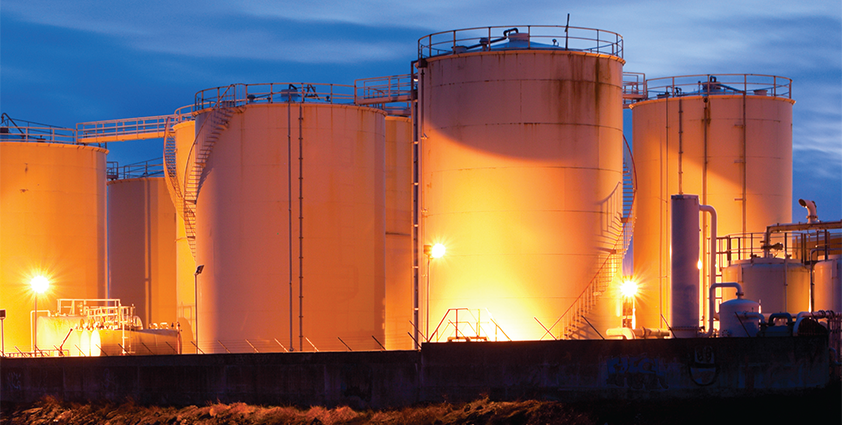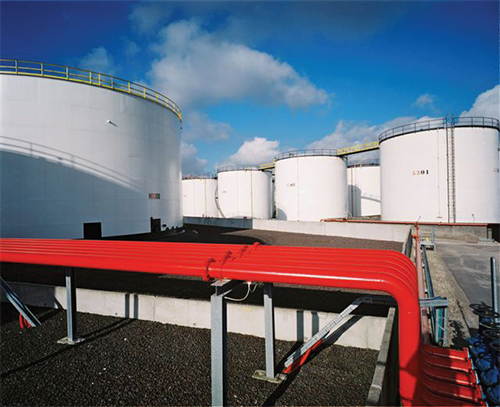
EuroTank Amsterdam
The master plan
Everyone associated with EuroTank Amsterdam (ETA), and the VTTI Group as a whole, shares the belief that this is a young, modern and, most importantly, an independent company at the forefront of the industry, dedicated to rendering various tank storage services to customers working within the oil and gas sector,” states Frank Schaper, general manager of EuroTank Amsterdam.
The company’s history is intertwined with that of the port of Amsterdam, specifically the area the site sits on, one that has been in use since the 1950s. It wasn’t until 2006 that the name ETA was adopted in the aftermath of Vitol’s acquisition of the terminal, a move that brought the site into the larger VTTI Group: “In the meanwhile, ETA is one of ten tank storage terminals within the VTTI Group and the largest in terms of capacity,” Frank continues. “ETA’s key activities are the storage and blending of clean petroleum products, specifically gasoil and gasoline qualities.
“At present the terminal has a total storage capacity of 1.4 million cubic metres, generated by a collection of approximately 240 storage tanks, ranging in size from 1000 cubic metres to 37,500 cubic metres. The nature of ETA’s inventory is again linked to the age of the site, but its large number of smaller sized tanks continue to positively contribute to the terminal’s blending operations.”
 With 95 per cent of all ETA’s product movements coming in and going out of the port via ships and barges, the terminal has built up a series of 11 jetties to handle such demand. Five of these are dedicated to handling sea-going tankers measuring up to 45 feet in draft, while the other six are predominantly used by barges. In addition to that ETA is rendering services to rail tankers, while four loading bays are available to also load trucks with various gasoline and gasoil products.
With 95 per cent of all ETA’s product movements coming in and going out of the port via ships and barges, the terminal has built up a series of 11 jetties to handle such demand. Five of these are dedicated to handling sea-going tankers measuring up to 45 feet in draft, while the other six are predominantly used by barges. In addition to that ETA is rendering services to rail tankers, while four loading bays are available to also load trucks with various gasoline and gasoil products.
In 2008 ETA launched what it described as ‘one of the most significant transformation programmes ever seen at a European terminal’. Know as the ‘Master Plan’, the programme is based on the concept of investing more than 100 million euros over a multi-years period into new infrastructure to the terminal and modernising existing facilities: “The Master Plan is, in essence, a living document that ETA constantly updates as it receives fresh market information,” Frank explains. “The purpose of the document is to bring ETA’s terminal up to a standard that fully meets the needs and expectations of its customers. This is a wide reaching programme aimed at tackling every aspect of the terminal’s operations and ensuring it always meets its legal obligations.
“One example of the work initiated through the Master Plan was the installation of a series of vapour recovery units. These allow ETA to carry out gasoline-based activities within a closed system. What this in turn means is that the terminal no longer releases gasoline vapour emissions into the atmosphere, instead they are recovered by the units and reprocessed into gasoline liquids, which are then reused in alternative products.”
Equally fundamental to ETA is its commitment to maintaining the highest HSE standards: “ETA has a very strong, in-built safety culture and is always working to improve its performance in this hugely important area of the business,” Frank highlights. “The terminal is currently in the midst of modernising its fire fighting installations, automating its system and installing modern detection techniques to better improve reaction times. Of course these improvements need to be financed and thus ETA continues to commission additional applications to handle a larger workload. Over the next several months the terminal will receive four more gasoil tanks, increasing overall capacity by a further 75,000 cubic metres.”
With the Master Plan in full flow Frank reveals that ETA can look forward to even greater developments in the near future: “ETA will continue to revamp its current infrastructure over the next few years with many of its older tanks being replaced by larger, modern units. At the same time the plan is to create additional land within the terminal’s boundaries in order to take on additional business opportunities and increase ETA’s service and product portfolio.”
As Frank concludes, there are many reasons to be optimistic about the future of ETA: “When looking at ETA you can see a culture within the company that really drives it forward. At its core it has a team of motivated, ambitious, customer focused individuals, each of whom is passionate about delivering quality service all year round. Together they help form a lean, non-bureaucratic organisation, brave enough to take risks and able to make decisions quickly and efficiently.
“It is my personal belief that as a team we can take the company to a point where, five years from now, ETA exists as an ultra-modern tank storage terminal with an even bigger capacity level, serving more customers with a wider range of products and services. By doing so ETA will also be playing its part in making the VTTI Group achieve its target of becoming one of the world’s largest independent storage companies serving the global hydrocarbon market.”
EuroTank Amsterdam
Services: Tank Storage